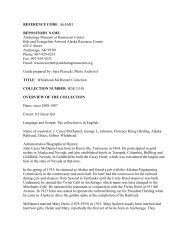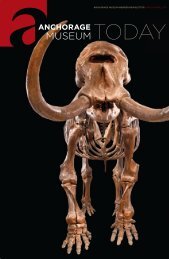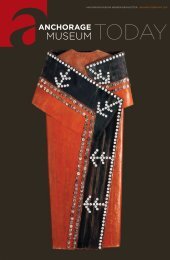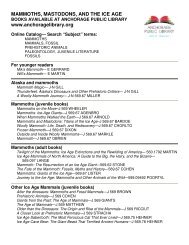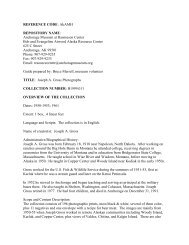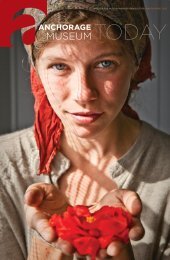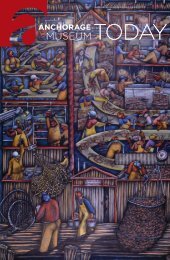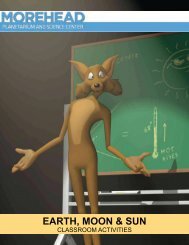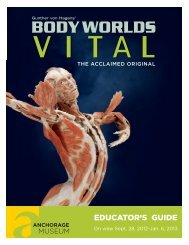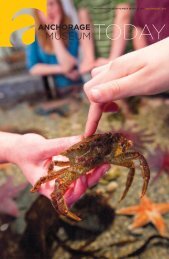2010 MEDIA KIT - Anchorage Museum
2010 MEDIA KIT - Anchorage Museum
2010 MEDIA KIT - Anchorage Museum
- No tags were found...
You also want an ePaper? Increase the reach of your titles
YUMPU automatically turns print PDFs into web optimized ePapers that Google loves.
www.anchoragemuseum.org<strong>2010</strong> <strong>MEDIA</strong> <strong>KIT</strong>
625 C Street<strong>Anchorage</strong>, Alaska 99501(907) 929-9200www.anchoragemuseum.orgMUSEUM OVERVIEWThe <strong>Anchorage</strong> <strong>Museum</strong>’s mission is to shareand connect Alaska with the world throughart, history and science. Located in the heartof downtown <strong>Anchorage</strong>, the museum offers aunique cultural experience for residentsand visitors.PRESERVING ALASKA’SINDOMITABLE SPIRITSIZE The <strong>Anchorage</strong> <strong>Museum</strong> is the largestmuseum in the state, with more than170,000 square feet of indoor galleriesand public space.ORIGINS The <strong>Anchorage</strong> <strong>Museum</strong> openedin 1968 with 60 borrowed Alaska paintingsand a collection of 2,500 historic andethnographic objects owned by the localhistorical society.COLLECTIONS The museum’s permanentcollection holds more than 25,000 objects,500,000 historical photographs, 12,000publications and 800 maps.VISITORS One of the 10 most visitedattractions in Alaska, the museum draws morethan 140,000 people a year, including 18,000schoolchildren.EXHIBITIONS The museum develops andshares celebrated exhibits with museumsaround the world. It also brings in majortouring shows such as “A T-Rex Named Sue”from The Field <strong>Museum</strong> in Chicago and“Star Wars: Where Science MeetsImagination” from the Boston <strong>Museum</strong>of Science and Lucasfilm, Ltd.PROGRAMS Through a rich set ofeducational programs for children andadults, the museum inspires people to gather,engage their senses and exchange ideas.Programs include lectures, performances, artclasses and family days.PERMANENT EXHIBITIONSALASKA GALLERY Dedicated to the history ofAlaska’s people from pre-contact times to thepresent, the gallery features artifacts from themany distinct Alaska Native cultures, Russianoccupation and the gold rush era. Displays alsohighlight 20th century historical events such asthe 8.4 magnitude earthquake of 1964 and theExxon Valdez oil spill.ART OF THE NORTH Reflecting the regionallandscape and people, the Art of the Northgalleries feature works by a diverse groupof artists, including an extensive collectionby Sydney Laurence, Alaska’s best-knownlandscape painter. Themes include exploration,lifestyles, wildlife and portraits.SMITHSONIAN ARCTIC STUDIES CENTER Thiscenter houses an exhibition of 600 rare AlaskaNative artifacts from the Smithsonian Institution.The exhibit is designed so visitors can easilycompare and contrast different Alaska Nativecultural groups.IMAGINARIUM DISCOVERY CENTER In thisarea, visitors can explore earth, life and physicalscience through hands-on exhibits. Displays putscientific concepts into an Alaska context.DOCENTS Experts on Alaska history,volunteer docents lead tours throughoutthe year.P. 1<strong>MEDIA</strong> INQUIRIESSarah Henning, Public Relations Coordinator, (907) 929-9231, shenning@anchoragemuseum.orgJanet Asaro, Director of Marketing and Public Relations, (907) 929-9229, jasaro@anchoragemuseum.org
625 C Street<strong>Anchorage</strong>, Alaska 99501(907) 929-9200www.anchoragemuseum.orgMUSEUM OVERVIEW (CONTINUED)FAVORITE THINGS TO SEEBisection of the trans-Alaska oil pipeline, oneof the seven wonders of the United StatesWoolly mammoth tusk from the PleistoceneLife-size dioramas depicting home life intraditional Alaska Native dwellingsContemporary Alaska Native art and craftCultural artifacts of Alaska Native peopledating back at least 10,000 yearsAlaska landscape paintings from the late 19thand early 20th centuriesMoon rock collected during the1971 Apollo 15 missionHOURS OF OPERATIONSUMMER HOURS Mid-May throughmid-September open daily 9 a.m. to 6 p.m.,including holidaysWINTER HOURS Mid-September through mid-May open 10 a.m. to 6 p.m. Tuesday throughSaturday, noon to 6 p.m. Sunday, closed MondayCall (907) 929-9200 to confirm hours, as hoursmay be extended during special exhibitions.ADMISSIONMUSEUM SHOPThe shop carries authentic Alaska Native art,contemporary crafts, books and gifts inspiredby the museum’s collections. The shop wasvoted one of the 10 best places to buy authenticAlaska Native art in an <strong>Anchorage</strong> Daily Newsreaders’ poll.MUSE RESTAURANTThe elegant and contemporary restaurant Muse,operated by The Marx Bros., uses freshingredients from the Pacific Northwest preparedwith Asian and European flair to createimaginative, elegant cuisine. The <strong>Anchorage</strong>Daily News rates the restaurant as a four-stardining experience.MUSEUM TOURS<strong>Museum</strong> docents offer one-hour tours daily frommid-May through mid-September. All tours areincluded with museum admission.The museum also offers familiarization (FAM)tours to tour group leaders, travel agents, mediaand others. The tours are an excellent way toget an overview of the museum’s permanentcollection and an update on special exhibitsand events. To schedule a FAM tour, call(907) 929-9230. Two weeks notice isappreciated, but every effort will be madeto accommodate each request.$10 adults$8 senior/student/military$7 ages 3 to 12Free ages 2 and youngerP. 2<strong>MEDIA</strong> INQUIRIESSarah Henning, Public Relations Coordinator, (907) 929-9231, shenning@anchoragemuseum.orgJanet Asaro, Director of Marketing and Public Relations, (907) 929-9229, jasaro@anchoragemuseum.org
625 C Street<strong>Anchorage</strong>, Alaska 99501(907) 929-9200www.anchoragemuseum.orgEXPANSION OVERVIEWThe $106 million expansion of the <strong>Anchorage</strong><strong>Museum</strong> heralds a new era for one of Alaska’spremier visitor attractions, broadening themuseum’s mission to include a new focus onscience – a natural evolution in a land where art,history and culture are deeply entwined withthe environment.The expansion, completed in May <strong>2010</strong>, includesan 80,000-square-foot wing and renovation ofthe existing building. Features include:SMITHSONIAN ARCTIC STUDIES CENTERA centerpiece of the expansion, the centerhouses an exhibition of rare Alaska Nativeheritage objects from the SmithsonianNational <strong>Museum</strong> of Natural History and theNational <strong>Museum</strong> of the American Indian.IMAGINARIUM DISCOVERY CENTER In thisarea, visitors of all ages explore earth, life andphysical science through hands-on exhibits.The center includes the TOTE KidSpace forages 5 and younger, where everything can betouched and children and parents can exploreart, history and science through play.CONOCOPHILLIPS GALLERY The <strong>Anchorage</strong><strong>Museum</strong> holds one of the most extensivecollections of contemporary Alaska Native artin both traditional and non-traditional styles. Inthis gallery, sculptures, carvings, paintings andmixed media help shape our understanding ofwhat it means to be Native in Alaska today.THOMAS PLANETARIUM Visitors canjourney to the stars, taking trips throughthe solar system. The planetarium alsohosts educational, entertaining films andpresentations that explore the night sky.TWO-ACRE COMMON This landscapedpublic area celebrates the environment andoffers a vibrant place for outdoor exhibits andgatherings.MUSE RESTAURANT Muse restaurant,operated by The Marx Bros., features anoutdoor patio and offers imaginative cuisine ina hip, lounge-like setting.MUSEUM SHOP The new museum shopcarries a wide variety of authentic AlaskaNative art as well as Alaska-made jewelry,fun learning games and toys for children, andbooks on Alaska culture and history.SPECIAL EXHIBITION GALLERY Thisflexible, 9,000-square-foot gallery space onthe addition’s third floor displays travelingexhibitions from around the world andspecial exhibitions from the museum’s vastcollections.CHUGACH GALLERY From this temporaryexhibitions gallery on the fourth floor, visitorscan enjoy a fantastic view of the ChugachMountains. Comfortable benches providevisitors a place to reflect on the view and therotating exhibits.BOB AND EVANGELINE ATWOOD ALASKARESOURCE CENTER The resource centerincludes the Allen Family Foundation ReadingRoom, where visitors can access the museum’s500,000 photographs, 12,000 publicationsand 800 historical maps.P. 3<strong>MEDIA</strong> INQUIRIESSarah Henning, Public Relations Coordinator, (907) 929-9231, shenning@anchoragemuseum.orgJanet Asaro, Director of Marketing and Public Relations, (907) 929-9229, jasaro@anchoragemuseum.org
625 C Street<strong>Anchorage</strong>, Alaska 99501(907) 929-9200www.anchoragemuseum.orgSMITHSONIAN ARCTIC STUDIES CENTEROVERVIEWIn the first arrangement of its kind, theSmithsonian Institution is loaning hundredsof Alaska artifacts to their place of origin andallowing access for hands-on study by AlaskaNative elders, artists and scholars. These culturaland historical treasures are exhibited in thenew Smithsonian Arctic Studies Center in the<strong>Anchorage</strong> <strong>Museum</strong>.The center houses more than 600 objects fromthe Smithsonian’s collections. These objectswere selected and interpreted with help fromAlaska Native advisers. Examples include an1893 Tlingit war helmet from the southeastAlaska village of Taku. The initial object loanperiod is seven years, with option to renew.VISITOR EXPERIENCEThe new, 10,000-square-foot Smithsonian ArcticStudies Center is located on the second floor ofthe <strong>Anchorage</strong> <strong>Museum</strong> addition.The Exhibition“Living Our Cultures, Sharing Our Heritage:The First Peoples of Alaska”This exhibition of more than 600 objectsdemonstrates how each Native nation is unique— and how all are connected. Visitors to thisexhibition will see many objects never displayedbefore, including an 1880s Iñupiaq caribou skinparka, a masterwork of Arctic clothing design,and a 1903 Tlingit crest hat made of wovenspruce root and mounted with a raven carving.Objects and information represent the historyand culture of Alaska Native peoples includingTlingit, Haida, Tsimshian, Athabascan, Eyak,Unangax, Sugpiaq, Yup’ik, St. Lawrence IslandYupik and Iñupiaq. Siberian groups are alsorepresented. The exhibition explores threeuniversal themes: Living from the Sea, Landand Rivers; Ceremony and Celebration; andCommunity and Family.Visitors learn about objects through touchscreens: They can zoom in on a photo of anobject and view it in 3-D or scroll through moreinformation, such as related oral histories.The exhibition also includes two multimediainstallations. A video installation about AlaskaNative life plays on seven large screens. A 3-Dsound art installation immerses visitors in theArctic through recordings of howling wolves,cracking ice and Alaska Native storytellers.The exhibit was curated by Smithsoniananthropologist Aron L. Crowell and assistantcurator Dawn Biddison.Public ResourcesGottstein Learning Center: This resource centerwithin the Smithsonian Arctic Studies Centeroffers public access to publications and filmsabout Alaska Native cultures, as well as aninteractive database of exhibit items.Exhibit catalog: Visitors may purchase theexhibition catalog “Living Our Cultures, SharingOur Heritage: The First Peoples of Alaska” inthe <strong>Anchorage</strong> <strong>Museum</strong> shop. Friends of theSmithsonian chose this as its official 2011 bookselection: More than 10,000 copies will begiven to qualifying Smithsonian donors. The315-page book emphasizes cultural continuity,placing these masterworks of the past into acontemporary context through essays by 20Alaska Native authors.P. 4<strong>MEDIA</strong> INQUIRIESSarah Henning, Public Relations Coordinator, (907) 929-9231, shenning@anchoragemuseum.orgJanet Asaro, Director of Marketing and Public Relations, (907) 929-9229, jasaro@anchoragemuseum.org
625 C Street<strong>Anchorage</strong>, Alaska 99501(907) 929-9200www.anchoragemuseum.orgSMITHSONIAN ARCTIC STUDIES CENTER (CONTINUED)RESEARCHResearch spaces for Alaska Native elders,artists and scholars working with theSmithsonian include:Cultural Consultation Room: One of themain purposes of the Smithsonian ArcticStudies Center is to provide access to thedescendents of the people who createdthese objects. So, object cases won’t besealed. Mounts were created to allow acertain amount of removal and handling whenculture bearers need to study an object in thisconsultation room. Casual museum visitorscan’t open the cases or handle the objects:That access is reserved for those workingwith Smithsonian staff to build knowledge ofAlaska Native history and culture.Gillam Archaeology Laboratory: Thelaboratory enables Alaska Native communitiesand archaeologists to collaboratively studyartifacts, animal bones and environmentalevidence collected from ancient settlementsand camp sites.THE PROJECT: Sharing KnowledgeExhibition items were chosen as part of a longtermSmithsonian Institution endeavor calledthe Sharing Knowledge Project. Through thisproject, members of indigenous communitiesfrom across Alaska and northeast Siberia areworking with the Smithsonian to interpret thewestern Arctic and subarctic collections of theNational <strong>Museum</strong> of Natural History and National<strong>Museum</strong> of the American Indian in Washington,D.C. These combined holdings are vast — morethan 30,000 items, many dating to the late 19thand early 20th centuries. The great majorityhave never been published, exhibited or seen byAlaska Native people.Collaborative work began in 2001 with a seriesof study trips to Smithsonian museums inWashington, D.C. by more than 40 Native eldersand regional representatives. Regional AlaskaNative organizations elected the participants,who then helped select objects destined for thenew Smithsonian Arctic Studies Center.The project is intended to make Smithsoniancollections accessible to all, support crossculturallearning and provide resources forthe study and perpetuation of Alaska culturalheritage. For more information, visithttp://alaska.si.edu and www.mnh.si.edu/arcticBACKGROUNDThe Smithsonian Arctic Studies Center,established in 1988, is a federal research andeducation program focusing on peoples, history,archaeology and cultures across the circumpolarNorth. The center is part of the SmithsonianInstitution’s National <strong>Museum</strong> of NaturalHistory. In 1994, the center partnered with the<strong>Anchorage</strong> <strong>Museum</strong> to open a local location.________________________________________Exhibits in the Smithsonian Arctic Studies Centerwere designed by Ralph Appelbaum Associates,Inc., New York, whose client list includes TheNewseum, Washington, D.C., and the American<strong>Museum</strong> of Natural History, New York.P. 5<strong>MEDIA</strong> INQUIRIESSarah Henning, Public Relations Coordinator, (907) 929-9231, shenning@anchoragemuseum.orgJanet Asaro, Director of Marketing and Public Relations, (907) 929-9229, jasaro@anchoragemuseum.org
625 C Street<strong>Anchorage</strong>, Alaska 99501(907) 929-9200www.anchoragemuseum.orgSMITHSONIAN ARCTIC STUDIES CENTER (CONTINUED)QUOTE SHEET“We can shoot this arrow up in the air. I wonder,how far will it go? That’s the future. That’s whatwe were here for: future generations need toknow our cultures.” — Trimble Gilbert, Gwich’inelder, summing up a week spent in Washington,D.C., with other Athabascan elders to documentthe Smithsonian collections“What does it mean to be Haida? The answernow is different from that of the past, obviously.We need to know our history and learn from it;we need to know our culture and draw strengthfrom it. We need to make it work for us today.”— Jeane Breinig, Haida, exhibition adviserand English professor at the University ofAlaska <strong>Anchorage</strong>“I once asked my late grandmother why weYup’iks used dance fans and headdresses andeverything else to dance. Her answer was simpleand poignant. She said, ‘Our ancestors are happyto see us so beautiful.’” — Chuna McIntyre,Central Yup’ik Eskimo, exhibition adviser andfounder of Nunamfca (Of Our Land) Yup’ikEskimo Dancers“The Yupik culture has a very long, rich history,and at the Smithsonian you will see artifactsthat our ancestors created hundreds or eventhousands of years ago. I can only imaginethose old-timers, sitting next to the seal oil lampduring the wintertime and etching walrus ivorywith such skill.” — Paapi Merlin Koonooka, St.Lawrence Island Yupik, exhibition adviser andwhaling captain“When he was dying my grandfather called meto his bedside. I was fourteen years old. He said,‘I want you to go back home. I want you to goback to Haines, and I want you to build a fire inthe clan house.’ What he was saying is that mygeneration had to rekindle the fire of our cultureand language. That became our responsibility.”— Rosita Worl, Tlingit, exhibition adviser andanthropology professor at the University ofAlaska Southeast“This exhibition places these masterworks ofthe past in the context of people’s lives today.Many of these artifacts were produced a centuryago. It’s all about continuity of the meaningsand knowledge held in these pieces.” — AronCrowell, Director of the Arctic Studies Center’sAlaska office and curator of the exhibition“Living our Cultures, Sharing Our Heritage:The First Peoples of Alaska”“From concept to installation, Alaska Nativeelders and advisors were intimately involvedin this exhibit’s development. The knowledgegained from this close interaction betweenobject and person will be shared with thecommunity and become an important resourcefor future generations.” — James Pepper Henry,<strong>Anchorage</strong> <strong>Museum</strong> Director and CEO________________________________________Alaska Native adviser comments are frominterviews conducted as part of the SharingKnowledge Project. Administrator commentswere gathered by the <strong>Anchorage</strong> <strong>Museum</strong>.P. 6<strong>MEDIA</strong> INQUIRIESSarah Henning, Public Relations Coordinator, (907) 929-9231, shenning@anchoragemuseum.orgJanet Asaro, Director of Marketing and Public Relations, (907) 929-9229, jasaro@anchoragemuseum.org
625 C Street<strong>Anchorage</strong>, Alaska 99501(907) 929-9200www.anchoragemuseum.orgIMAGINARIUM DISCOVERY CENTEROVERVIEWThe Imaginarium Discovery Center is astimulating, hands-on science center designedto make earth, life and physical sciences fun forall ages. The center’s displays and programsspark intellectual curiosity and imagination—the foundations for scientific learning.HISTORYThe Imaginarium, Alaska’s only hands-on sciencecenter, merged with the <strong>Anchorage</strong> <strong>Museum</strong>in June 2008, adding science to the museum’smission. The Imaginarium’s former facility onFifth Avenue closed in August 2009. It reopenedMay <strong>2010</strong> within the <strong>Anchorage</strong> <strong>Museum</strong>as the expanded, state-of-the-art ImaginariumDiscovery Center.FACILITYThe new 9,000-square-foot ImaginariumDiscovery Center has 65 percent more exhibitspace than its former location. When themuseum’s shared spaces and planetarium areincluded, the result is a science center nearly fivetimes as large as the previous Imaginarium.The center houses more than 80 exhibitsincluding bigger, better versions of theImaginarium’s most beloved features, and triedand-trueexhibits from the world’s best sciencemuseums. About 25 percent of the exhibits wereconceived specifically for this center.The Imaginarium Discovery Center uses differentmethods of exploration to make learning aboutscience engaging.BP Kinetic SpaceThis area focuses on physics, such as principlesof energy, force and motion.AIR CANNON Visitors aim a pivoting aircannon at moving targets to understand theexistence and movement of air.HOIST CHAIR Sitting in specially designedchairs, visitors experiment with leversand pulleys to haul themselves vertically,demonstrating how mechanical systems canlower the force needed to lift something.INFRARED CAMERA The heat visitors give offis detected by a thermographic camera, sovisitors see themselves in the infrared rangeon a large screen.Thomas Planetarium and Planetarium HallThe 48-seat planetarium focuses on astronomy,the Earth’s atmosphere and the solar system.MAGIC PLANET A 24-inch spherical screenwith images projected from inside, thisinteractive globe uses NASA and NOAAimagery so visitors can see the Earth’sweather patterns, how the planet would lookif the oceans were drained and much more.The globe screen also transforms into otherplanets so visitors can examine, for example,craters on the moon, the polar ice caps ofMars or the Great Red Spot of Jupiter.AURORA IN A BOX This magnetized metalsphere simulates Earth and allows visitorsto introduce different conditions to createan aurora.P. 7<strong>MEDIA</strong> INQUIRIESSarah Henning, Public Relations Coordinator, (907) 929-9231, shenning@anchoragemuseum.orgJanet Asaro, Director of Marketing and Public Relations, (907) 929-9229, jasaro@anchoragemuseum.org
625 C Street<strong>Anchorage</strong>, Alaska 99501(907) 929-9200www.anchoragemuseum.orgIMAGINARIUM DISCOVERY CENTER(CONTINUED)Bubble SpaceThe space features bubbles both as items ofplay and as tools to understand surface tension,shape and light reflection. It includes aBig Bubble that creates a cylinder-shapedbubble large enough to fit one adult andone child inside.TOTE KidSpaceSince this inquiry-based gallery is specificallydesigned for infants and children through age 5,everything can be touched. Children andparents can explore art, history and sciencethrough play.SMART FLOOR A video projection onthe floor senses and responds to humanmovement. As children crawl, walk or runacross the floor, it responds like a pond –water ripples, plants and flowers grow anddragonflies flitter.SUN SPOT A padded area surrounding around waterbed for the youngest childrenprovides safe, gentle motion for crawlers andtoddlers, with built-in seating for parents.OTHER TACTILE EXPERIENCES include anart wall, book nook and puppet stage.Earth and Life ScienceThis area focuses on earth sciences includinggeology, geography and life sciences, with anemphasis on zoology.EARTH AND ICE SOUNDS This 3-D soundinstallation features nature recordings madein Alaska, such as a polar bear groaning, aglacier calving and wolves howling.CREATURES NEAR AND FAR Check out thesnapping turtle aquarium, alligator aquarium,moon jellies tank and marine touch tank.SHAKE TABLE Visitors can erect a building,place it on the earthquake shake table,simulate an actual historic earthquake andobserve how well their building withstandsthe tremors.LIQUIFICATION A working modeldemonstrates how Cook Inlet clay liquefieswhen disturbed by tremors.________________________________________Exhibits in the Imaginarium Discovery Centerwere designed by Ansel Associates, Inc. of PointRichmond, Calif., a leader in creating effective,exciting content for science centers. The firm’sprevious clients include the Oregon <strong>Museum</strong> ofScience and Industry, Portland, Ore., and PhaenoScience Center, Wolfsburg, Germany.P. 8<strong>MEDIA</strong> INQUIRIESSarah Henning, Public Relations Coordinator, (907) 929-9231, shenning@anchoragemuseum.orgJanet Asaro, Director of Marketing and Public Relations, (907) 929-9229, jasaro@anchoragemuseum.org
625 C Street<strong>Anchorage</strong>, Alaska 99501(907) 929-9200www.anchoragemuseum.orgDESIGN HIGHLIGHTSBUILDING ARCHITECTDavid Chipperfield ArchitectsLondon, EnglandARCHITECT OF RECORDKumin Associates, Inc.<strong>Anchorage</strong>, AlaskaLANDSCAPE ARCHITECTCharles Anderson Landscape ArchitectureSeattle, WashingtonGENERAL CONTRACTORAlcan General, Inc.<strong>Anchorage</strong>, AlaskaPROJECT ADVISERRISE Alaska LLC<strong>Anchorage</strong>, AlaskaBUILDINGThe museum’s expansion was designed byDavid Chipperfield, an internationally-renowned,award-winning architect based in London.According to Chipperfield, the expansion’sdesign is intended to encourage an appreciationof the museum’s extraordinary naturalsurroundings. His most recent projectsinclude the reconstruction of theNeues <strong>Museum</strong> in Berlin.SITEMany factors were considered when designingthe <strong>Anchorage</strong> <strong>Museum</strong> site. The building andlandscape designers felt the site needed tocreate a bold presence, complement the buildingarchitecture, serve the museum’s programmingand provide respite from the adjacent streets.The site features a 2-acre public common withbenches, providing a place to have lunch orenjoy the outdoors. To fill out the rest of thesite, the designers looked to an icon of theSouthcentral Alaska landscape – deciduous birchtree forests. The result is a dramatic urban forestin the middle of the city.GLASS FAÇADEAnother key feature of the building is itsshimmering glass façade, made up of more than600 panels 4 feet wide and in varying heights.The panels provide ultraviolet protection andare fitted with blinds to shield the museum’scollections from the sun.P. 9<strong>MEDIA</strong> INQUIRIESSarah Henning, Public Relations Coordinator, (907) 929-9231, shenning@anchoragemuseum.orgJanet Asaro, Director of Marketing and Public Relations, (907) 929-9229, jasaro@anchoragemuseum.org
625 C Street<strong>Anchorage</strong>, Alaska 99501(907) 929-9200www.anchoragemuseum.orgMUSEUM EXPANSION GOES GREENThe <strong>Anchorage</strong> <strong>Museum</strong> is pursuing Leadershipin Energy and Environmental Design (LEED)silver-level certification for its 80,000-squarefootaddition. The LEED Green Building RatingSystem promotes sustainability by recognizingperformance in five key areas of humanand environmental heath: sustainable sitedevelopment, water savings, energyefficiency, materials selection and indoorenvironmental quality.The certification would make the <strong>Anchorage</strong><strong>Museum</strong> the municipality’s first LEEDcertifiedbuilding.This achievement will be particularly significantin a city that just started offering curbsiderecycling in fall 2008. A LEED certification wouldbe a major milestone in the city’s initiative,started in 2005 by then-mayor Mark Begich, tobecome greener.“It is our hope that by securing LEEDcertification, the museum will be an example ofsustainability for future public building projectsand other museums throughout the state,”said James Pepper Henry, <strong>Anchorage</strong> <strong>Museum</strong>director and CEO.ENVIRONMENTALLY FRIENDLYELEMENTS OF THEMUSEUM’S NEW WING:Uses locally produced materials wheneverpossible, including concrete aggregate andlandscape suppliesProvides an air quality management planduring and after construction to flush outcontaminants before occupancyAllows staff to control their work area lightlevels, resulting in energy cost savings andhigher productivityOffers increased energy performanceresulting from extensive testing of thebuilding “skin” and HVAC systemsEncourages use of alternative transportation,providing convenient bike racks andeasy access for pedestrians and publictransportation usersAims for a 20 percent reduction in wateruse through low flow or automaticplumbing fixturesPromotes recycling by providing local andcentral collection areasLEED certification will be determinedsummer <strong>2010</strong>.Minimizes the building footprint by creatingfour levels plus a basement, and maximizesthe planted landscape and green spaceUses recycled content building materialswhenever possibleP. 10<strong>MEDIA</strong> INQUIRIESSarah Henning, Public Relations Coordinator, (907) 929-9231, shenning@anchoragemuseum.orgJanet Asaro, Director of Marketing and Public Relations, (907) 929-9229, jasaro@anchoragemuseum.org
625 C Street<strong>Anchorage</strong>, Alaska 99501(907) 929-9200www.anchoragemuseum.orgFREQUENTLY ASKED QUESTIONSWhy was the <strong>Anchorage</strong> <strong>Museum</strong>expanded?Responding to requests from <strong>Anchorage</strong><strong>Museum</strong> members and visitors, as well asAlaska’s academic and artistic communities, themuseum wanted to add science to its missionand adopt a more hands-on approach tolearning. Alaska visitors asked for more touringexhibits from other areas. Visitors also wanted tosee more of the museum’s collection (nationally,most museums only display about 10 percent oftheir collections). To meet these requests, themuseum doubled its interior space.Does the expansion change the museum’smission or strategic direction in any way?Yes. By merging with the Imaginarium, themuseum has added science to its mission, whichis to share and connect Alaska with the worldthrough art, history and science. The expansionstrengthens that mission by providing a broaderrange of exhibits and educational experiencesfor visitors.How much did the expansion cost?The expansion project cost $106 million.Philanthropist Elmer Rasmuson donated 52percent of the cost. The museum received anadditional 16 percent in federal grants and 4percent from foundations. The state of Alaskadonated 16 percent, and the museum raised 10percent from individual donors and 2 percentfrom corporations.Will the expansion create any new jobs?The expansion has created several newpositions, including an IT director and a visitorservices manager. The staff will continue to growover time in proportion with our program andexhibit offerings.Is the addition wheelchair accessible?Yes. Ramps are located on Seventh Avenue andSixth Avenue that extend from the sidewalksonto the museum’s new, ice-free promenade andthere is an elevator inside the addition.What is the purpose ofthe new outdoor area?The site is an integral part of the expandedmuseum. In the public common, people canhave lunch, meet friends or just relax. Thearea can also be used for museum events. Thegrounds feature a 24-foot sculpture “Habitat”by English artist Antony Gormley as part of themunicipality’s 1 Percent for Art Program.Will the outdoor area be safe?Safety was a primary consideration in the site’slandscape design. A key element of the design isvisibility across the site. To achieve that, all treesare limbed (branches removed) up to 6 feet andshrubs will be no taller than 3 feet, providingopen sight lines. The landscape designer workedwith a lighting firm to ensure safe levels oflight are provided year-round, particularly inwinter months.P. 11<strong>MEDIA</strong> INQUIRIESSarah Henning, Public Relations Coordinator, (907) 929-9231, shenning@anchoragemuseum.orgJanet Asaro, Director of Marketing and Public Relations, (907) 929-9229, jasaro@anchoragemuseum.org
625 C Street<strong>Anchorage</strong>, Alaska 99501(907) 929-9200www.anchoragemuseum.orgFREQUENTLY ASKED QUESTIONS(CONTINUED)How will the landscape be maintained?The trees and plants are under warranty forthe first two years with the local companythat planted them. After that, the museum willcontract with an arborist and groundskeeper.The landscape design includes two elementsthat help reduce maintenance issues – the siteis fully irrigated and predominantly filled withnative plants that require less upkeep over time.Why are birch trees usedin the landscape design?Paper birch trees are one of the most culturallyand ecologically important and prevalent nativetrees in the <strong>Anchorage</strong> Bowl, which extendsfrom Cook Inlet to the foothills of the ChugachMountains. Birch forests are an iconic part ofthe region’s landscape, so they seemed anappropriate, meaningful choice.Where did the trees come from?About 250 birch trees were salvaged in summer2008 from a few sites in the area slated fordevelopment. The trees were cared for in anursery before they were replanted on themuseum site in summer 2009. They are about 16feet tall and will mature at 30 to 40 feet over thenext two decades.What’s happening to the Children’sGallery, a longtime fixture at the museum?The museum wanted to create a more holisticapproach to children’s education. Insteadof dedicating just one gallery to children’sactivities, kid-friendly elements are now addedto exhibits throughout the museum.The new Imaginarium Discovery Center has ascience focus but also includes art installationsand art activities for kids, such as a paintingarea, weaving wall and puppet stage.Where should I park?There is plenty of parking conveniently locatednear the museum. Public parking is available inthe museum garage on weekends and eveningsfor $1 per hour. There is metered parking alongSeventh Avenue and there are pay lots on SixthAvenue along A and B Streets, Fifth Avenue andB Street, and Seventh Avenue and C Street.Will admission rates change?The <strong>Anchorage</strong> <strong>Museum</strong>’s admission andmembership rates modestly increased in<strong>2010</strong>. The new prices reflect an expanded<strong>Anchorage</strong> <strong>Museum</strong> that includes, essentially,three museums in one with the addition of theImaginarium Discovery Center, and SmithsonianArctic Studies Center. Rates are $10 adults,$8 senior/student/military, $7 ages 3 to 12,free ages 2 and younger.Who will use theAtwood Alaska Resource Center?The photographs, publications and maps inthe Atwood Resource Center are an invaluablesource of Alaska information for students,academics, historians, curators, writers andartists who find background and inspiration fornovels, films, art projects or history reports.P. 12<strong>MEDIA</strong> INQUIRIESSarah Henning, Public Relations Coordinator, (907) 929-9231, shenning@anchoragemuseum.orgJanet Asaro, Director of Marketing and Public Relations, (907) 929-9229, jasaro@anchoragemuseum.org



